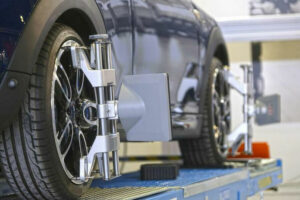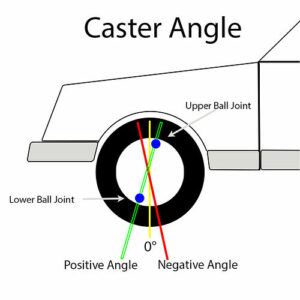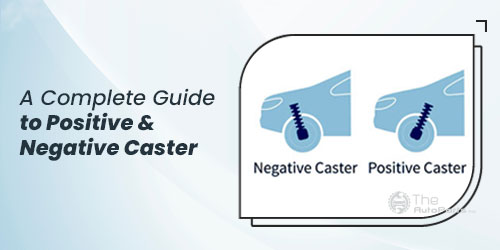Proper wheel alignment balances the car properly while driving. All four wheels must be aligned properly, while the steering wheel must remain straight. Poor alignment often leads to issues like uneven wear and rough handling. Therefore, getting your wheels properly aligned while taking them for regular maintenance is vital.
What Exactly Does Wheel Alignment Means?

Wheel alignment refers to the geometric arrangement of wheels have with each other, the car, and the road. Ideally, the wheels must be parallel and perpendicular to the road with the axis. This gives minimum rolling resistance, friction, and optimum traction to the car. The vehicle has several wheel alignment angles, while the caster of the car is the main component that has been covered in the article.
What Is a Caster?

Forward or backward tilt of steering axis with respect to vertical lines has been possible due to the caster in the car when observed from sideways. The caster impacts the steering ability, effort and return of the car on the wheels. This is often ignored as it doesn’t lead to direct wear. The caster falls into two categories positive and negative.
What are Some of the Ways to Measure Caster?
Caster is generally measured in degrees. It is measured via vehicle turning wheels present at the front as they’re responsible for steering. There are two ways to calibrate the caster angle:
- Take turning plates and a digital camber or caster gauge caster
- Invest in professional alignment rack and equipment
Positive & Negative Caster: What’s the Difference?
In the case of the positive caster, the lower ball joint is placed in front of the upper ball joint(strut mount).On the contrary, the negative caster’s lower pivot point stays behind the upper pivot point and is distinguished based on the following features:
Positive Caster
- The handling becomes stable with a positive caster and helps the car move straight with little or no wheel correction. It helps the steering wheel return to a position after a turn.
- It is generally installed in racing cars, thereby giving high-speed stability, and cornering also surges the effort.
- A positive caster helps to increase the steering effort and helps you suspect road shocks while driving on uneven roads.
- It is beneficial for the present-day vehicles as they remain unaffected by heavier steering due to power steering.
- Positive caster offers excellent straight-ahead stability due to the wheel’s self-aligning torque.
Negative Caster
- Present-day vehicles don’t have negative caster inside them. It was commonly found in older cars with no power steering to minimize the steering effort.
- Although it improves the steering, it doesn’t offer handling and stability as you drive in a straight line.
- If the car starts moving towards either side while driving, it is possibly due to a negative caster.
- Wheels with negative or equal caster become unstable and need constant steering wheel movement while moving on a straight line.
Important Note: The Caster surges when the car carries a heavy load at its rear.
Common Causes of Caster Misalignment
The excessive difference in the vehicle’s side to side makes the car move towards either side of the road. In certain cases, a slight difference is expected during the alignment, while the caster must stay within half a degree in the case of side to side.
Caster Misalignment Takes Place Due to the Following Reasons:
- Bent Spindle
- Bent Strut
- Bent control arm
- Changes in the location of the strut tower
- Worn or broken control arm bushing
- Weak or broken spring
Inspect the caster adjustments thoroughly, and caster replacement along with its parts would resolve the issue to a great extent. Ride height is another aspect that impacts the caster overloading or spring sag is the root cause of the problem. This leads to steering instability and increases the vehicle’s steering effort.
After obtaining the specifications, the ride height difference must be rectified as soon as possible by carrying out the necessary adjustments. Towing or hauling heavy loads, vehicles must install accessories such as variable-rate springs, air springs, overload shocks, and air-assist shocks to prevent ride height issues.
How to Perform Caster Adjustment?
It is impossible to perform caster adjustment in certain vehicles. Most drivers adjust it by moving the upper or lower pivot points in the forward and backward direction with the help of using the shims, slots, strut rods, or eccentric cams. The caster can be stable only if it is equal from both sides. If it is impossible, try taking the caster towards the right side than the left with half a degree difference.
How Much Does Caster Cost?
The caster adjustments are performed to the positive side. The caster replacement cost generally falls between $100-$250 depending upon the car type and wheel alignment.
However, buying it car parts and accessories online-store like ‘The Auto Parts Shop‘ can help you save money. Also, by watching the videos, you can resolve the issue in no time.
The Bottom Line
Caster is an integral car component, and complete information will help you resolve the issues. Therefore, performing caster replacement along with its components as ignoring the issue leads to expensive repairs in the future.
